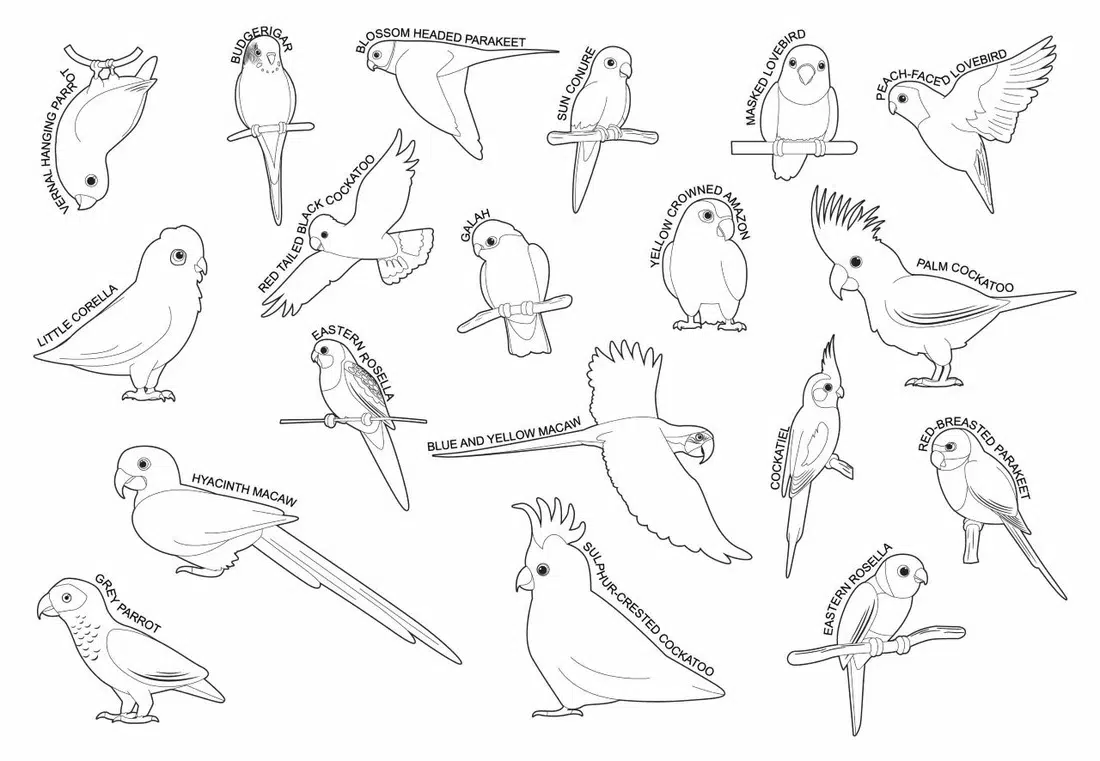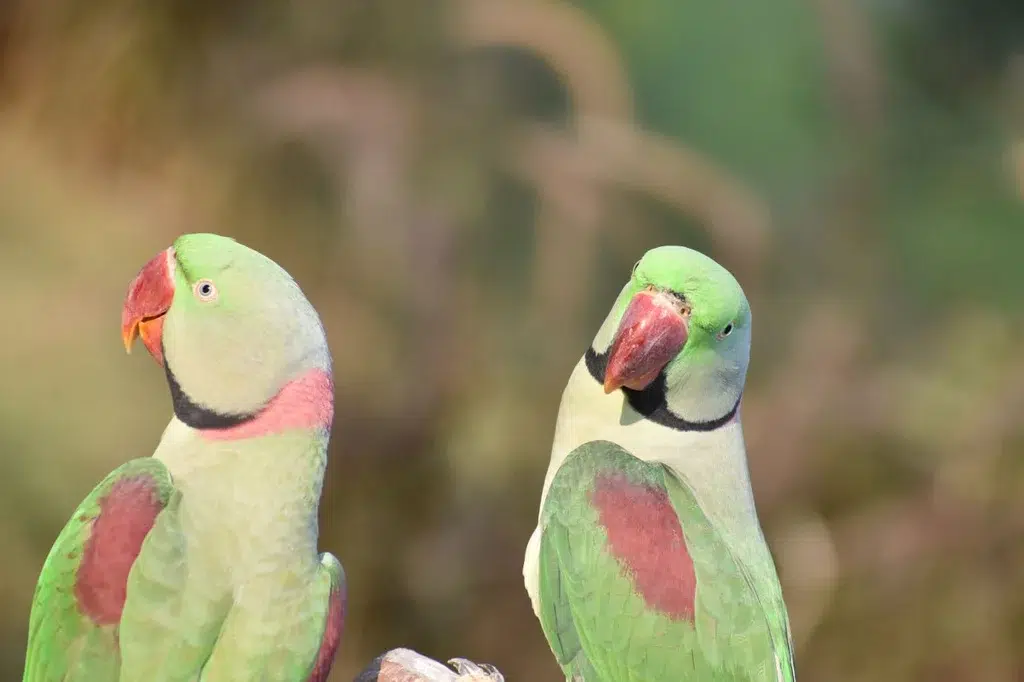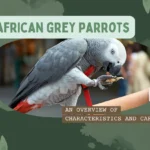
Parakeet vs Parrot – What’s the Difference?
Why do some people call a bird a parrot, while others call them a parakeet? Do they look alike, communicate in the same way, or are they just two words used interchangeably to describe the same bird? If you have ever wondered about the difference between a parrot and a parakeet, the answers may not be so farfetched. Let us discuss the differences and similarities, and also take a quick look at the largest and smallest parrots and parakeet species!
Classification of parrots vs parakeets
So, what’s the difference between parrots and parakeets? Parrots are a special group of birds of 402 species in the order of Psittaciformes. The three superfamilies within this order are Psittacoidea, also known as “true parrots”, Cacatuoidea such as cockatoos and cockatiels, and Strigopoidea which refer to the New Zealand parrots. All these parrots can be found in different regions across the world. Under the Psittacoidea superfamily, there are families such as Psittacidae, Psittaculidae, Psittrichasiidae, etc. within which some genera of birds like Pyrrhura, Enicognathus, Psittacula, Aratinga (plus many others) consist of parakeets.
Very broadly-speaking, the word “parakeet” is used to refer to a wide spectrum of small sized seed eating parrots with slender build and long narrow tails. The word “small” here is important, as there are large parrots with long tails, such as macaws, which do not fall under the category of parakeets. Other small parrots such as cockatiels also have long tails, but they are in the Cacatuoidea superfamily, not the Psittacoidea superfamily. Hence, cockatiels are not parakeets.


This is the taxonomy of parrots from domain to subfamilies. Parakeets fall under certain subfamilies such as Arinae, Platycercinae, and Loriinae.
All parakeets are parrots, but not all parrots are parakeets. To be termed a “parakeet, there are a few criteria they have to meet: 1) They are part of the Psittacoidea superfamily; 2) They are small in size; 3) They have long tails
Many of these birds have layman names to them. For parakeets, they are often referred to as:
- Budgerigars (or budgies)
- Conures
- Asiatic parrots such as Indian ringneck parakeets (ringnecks) and Alexandrine parakeets (Alexandrines)
- Monk parakeets (quaker parakeets, or quakers)
- Etc.
Why don’t we just call them all “parrots”?
To provide the necessary care and engage properly with your bird, it is helpful you can tell the difference between species. This is especially so if you are looking for information about parrot care – you will need to know what specific type of parrot you have, or are intending to buy, in order to find relevant information about caring for the species.
The first step is to know the species of the bird that you are buying. This can help guide your choice in terms of what to purchase, nutrition, method of training, reward system, understanding their emotions, etc., and will generally help you maximize your engagement with your pet, especially with respect to your expectations from it. Understanding your pet is essential to building the best and most successful relationship with it in the long term.
Parrots, in general, range very widely in size. The smallest parrot known as the Buff–faced Pygmy Parrot is about 3 – 4 inches long, while the Hyacinth Macaw which is considered the largest parrot can grow as big as 40 inches long. Parrots also have a really long lifespan. Some parrots like the Kakapos can live up to 95years if properly fed and well taken care of. Parrots can also be found in a wide variety of habitats ranging from the cold and windy alpine mountains to more temperate and tropical rainforests.
Another interesting trait of parrots is that they are very sociable birds and love to live in groups as part of a flock. It is even believed that they may sometimes esteem their human owners to be relatives, and could interact with them as part of their community. Some common pet species among parrots are; the popular African Gray, Amazons, Conure, and Lovebirds.
Differences between parrots and parakeets
Having established that parrots and parakeets are not necessarily the same, even though one is a subfamily of the other, there are some actual noticeable differences between the two such as:
Origin of their names
The word parrot is derived from the French word “perrot”. However, the origin of the word parakeet is not really known, but is said to be a derivative of either the Old French word “paroquet”, the Spanish word “periquito”, or the Italian word “parrochetto”, all of which are words used to describe small long tailed and brightly coloured parrots. Today, the French word for “parrot” is “perroquet“, which seems to be a combination of both “perrot” and “paroquet“!
Lifespan
Knowing the lifespan of your pet guides you on how much commitment is expected of you. While parakeets can live for roughly 20 years, larger parrots may live for as long as 95 years with excellent diet and care, often even outliving their owners. If you are looking for a lifelong pet companion, a larger parrot may be a better choice. However if you are looking for a small bundle of joy that is less likely to outlive you, a parakeet may be your best bet.
Physical appearance
To an untrained eye, parrots and parakeets could easily pass for the same bird, especially smaller parrots like the Buff–faced pygmy parrot that is relatively smaller in size than an average parakeet. However, upon closer observation, one would find out that there are small noticeable differences in appearance. The list below is a broad generalization of different physical appearances of parakeets vs parrots:
- Weight: As there are many parrots that are larger in size than parakeets, they naturally tend to weigh more than parakeets. Of course, there are small parrot species that are smaller than parakeets, which would also weigh less than them. However, all parakeets are generally small in size, which is why weight can be a point of difference when classifying parakeets vs parrots.
- Length: In terms of length, parakeets are generally small to medium-sized birds. On average, parrots can range anywhere between 3 inches (7.5 cm) to 40 inches (100 cm) in length, while parakeets tend to be between 7 inches (17.5 cm) and 24 inches (60 cm).
- General Body Structure: Apart from the obvious differences in weight and size, parrots tend to have more prominent beaks than parakeets. Except for macaws, many parrots’ tail feathers also tend to be distinctively shorter when compared to their body length than parakeets. Parakeets have long tail feathers that appear to be a bit more similar to their body length (i.e. the length of their tails are similar to the length of their bodies).
- Color: Even though both birds are an extremely beautiful sight to behold, several parakeets generally tend to be more colorful than most parrots, or having striking feather coloration in certain parts of their bodies. Again, this excludes the likes of macaws, which are very varied in color. No wonder there are so many products around from Acrylic Pins to phone cases showcasing their incredible colors.
Similarities between parrots and parakeets
Mating and breeding
Like many other birds, parrots and parakeets is that they are monogamous in nature, and once they find a mate “the one”, they tend to stick to it for the rest of their lives (or at least, for the breeding season). However, the age of maturity for breeding may differ between both. Whilst parakeets and small parrots may be ready for breeding at a little above one year old, parrots may wait till they are 2 – 4 years for medium sized parrots, and 3 – 6 years for bigger ones. Parrots and parakeets alike prefer to mate in warmer seasons like spring to enable them quality time to nurture their offspring before the colder months set in.
Talking abilities
It is a common belief that parrots are talkative in nature, however, not all parrots can talk. Likewise, parakeets are often known to talk, but again, this boils down to the species and also the individual parrot or parakeet. In terms of tonality and pitch, parrots are louder and tend to have a harsh tone to their voices, while parakeets are more soft spoken and have voices that sound almost musical. A general assumption is that male parakeets talk and sign much better than female parakeets perhaps as a mating strategy.
It is not encouraged to get a parrot for its ability to talk, even if this is what attracts most of us to begin with! To understand more about parrots talking, read our article here.
Habitats
Parrots have a wide variety of species and so can be found in a broad spectrum of habitats from very cold and windy areas to much warmer and tropical regions, parakeets generally tend to be found naturally in warmer climates such as tropical zones. However, in recent times, both types of birds can be found in diverse climes and countries across the globe, in the homes of pet owners as well as in pet shops.
Dietary needs and preferences
Parrots and parakeets love a vast array of foods ranging from seeds and nuts, to even a little bit of animal protein. There dietary preferences are roughly constant irrespective of whether they are freely roaming in the wild, or nesting quietly in a cage. However, as with other things, there are slight differences in what would or would not constitute a good meal for both parrots and parakeets, depending on the species.

Read more about parrot diets in our article, What Do Parrots Eat
Parrots and parakeets generally should be given a good mix of fresh vegetables, fruits and pellets or seeds, and will often enjoy small amounts of animal protein, wild foraged fruits, flowers and corn if available. These birds enjoy nuts like almonds, cashew, hazel nuts, and Brazilian nuts and this could form very good treats for training. However, they should not eat fatty, salty, sugary, or fried human foods, as well as tea, coffee and alcohol.
As a result of their feeding preferences, parrots and parakeets can serve both as propagators and pests at the same time. Their love for cereals and fruit crops make them easy targets as pests to cereal and fruit gardeners, however, through their feeding habits they provide mutual support to plants as plant protectors in the sense that they are predators to most plant pests like insects. Furthermore, parrots provide multiple services for plants as genetic linkers, and seed facilitators for secondary dispersers.
Personalities
Parrots and parakeets are active, energetic, and social birds. Many of them have very mischievous and cheeky personalities, and they become more social the more intelligent they are. From several anecdotes of bird owners, parrots and parakeets generally love companionship and can be very loving and devoted if patiently attended to. Parrots can be very gentle, but can get really irritated if provoked. On the other hand, the emotional response of a parrot will depend largely on the particular species, its ownership history, and the amount and type of training you put effort in with it. Generally, most parrots and parakeets can be trained to be sociable to human beings, and if shown good amount of attention they can form very special bonds with their caregivers and owners.
What is the largest parakeet

Alexandrine parakeets (Psittacula eupatria, Palaeornis eupatria) are the largest in size of all the parakeet species. They are commonly found in India, the Himalayas and some parts of Indochina, but have spread during the last century to other parts of the world such as Europe and North America, due to feral populations. Many of them are known for their ability to talk, and their gentle nature compared to their similar-looking Indian ringneck parakeets.
Alexandrine parakeets can grow up to 24 inches/60 cm in length from head to tail, which makes them rather large birds compared to the rest of the parakeets! They have characteristic red patches of feathers on their shoulders (which Indian ringnecks do not have), and for this reason they are also known as epauletted parakeets.
DID YOU KNOW? Indian ringneck parakeets and Alexandrine parakeets are two very similar-looking Asiatic parrots.The key difference is that Alexandrines are larger in size, have a bigger beak, and characteristic red “shoulder patches” on their wings. Indian ringneck parakeets do not have these shoulder patches.
What is the largest parrot

Hyacinth macaws (Anodorhynchus hyacinthinus) are the largest parrots among all the parrot species. They can grow as long as 40 inches/100 cm long from head to tail! These macaws are known for their sharp, hooked beaks adapted to crack tough nuts, as well as their cobalt blue plumage which is very impressive and striking. Hyacinth macaws also have a characteristic bright yellow patch around their eyes and at the corner of their beaks.
Similar to the hyacinth macaws are their cousins, the glaucous macaw, and the Lear’s macaw. The glaucous macaw is relatively distinguishable as they are turquoise in color instead of the bright blue, but differentiating the Lear’s macaw might be less easy. Lear’s macaw also have bright blue feathers like the hyacinth, but they have a slightly greenish tinge rather than pure blue. Also, the shape of the yellow patch at the corner of their beaks is more rounded rather than long, like in a hyacinth.
Both the glaucous macaw and the Lear’s macaw are smaller in size than a hyacinth macaw.
DID YOU KNOW? The hyacinth macaw is threatened in the wild due to habitat loss and exploitation for the pet trade in the past. Today, international efforts are being carried out to recover populations in the wild, and captive breeding efforts are contributing to ensuring the survival of this magnificent species.
What is the smallest parakeet

Among the parakeet species, the smallest-sized ones would have to be budgerigars, also known as budgies (Melopsittacus undulatus). Often, when someone says they have parakeets, there is a very high chance that they are referring to budgies. Budgies are very popular family pets due to their small size and fascinating behavior. They are often suggested as beginner pets, but like other parrots, proper care need to be provided for them to thrive!
Native to Australia, these beloved parakeets also have an interesting scientific name – Melopsittacus means melodious parrot, and undulatus means undulating, referring to the wavy black patterns on their plumage that are characteristic of the species.
DID YOU KNOW? Budgies are sexually dimorphic when mature – male budgies have a blue cere (skin around their nostrils) while female budgies have a flesh-colored cere. However, in lutino or albino budgies, both males and females have flesh-colored ceres.
What is the smallest parrot

The buff-faced pygmy parrot (Micropsitta pusio) is the smallest of all parrot species, measuring at 3.4 inches/9 cm, which is just slightly larger than a human’s finger! They are not commonly kept as pets due to their very specific diet involving fungi and lichen on tree barks.
These tiny parrots can be found also in a very specific region on Earth – Papua New Guinea. They are not studied very much and the current population in the world is not known. Mature buff-faced pygmy parrots develop a blue-colored crown.
Final Notes
If you started this article with a bit of confusion as to what differentiates a parrot from a parakeet, then you must have spotted and outlined some very noticeable differences by now.
The easiest way to differentiate between both is to look at their tail feathers. The tail feathers of parakeets will always be long, and similar to the length of their bodies, while parrots generally have shorter tail feathers when compared to their body length. The exceptions to the tail length rule are macaws (very large parrots) and cockatiels (which have a characteristic crest of feathers on their heads) – these are easily distinguishable.
Making a choice between a parrot and a parakeet can be a bit confusing initially, but once you understand how to differentiate them, and have better awareness of the different species, it will allow you to find better and more specific information about the type that you want to go for as a pet. Parrots can be really engaging and exciting once you get to know them. From their sociable flocking habits, to their ability to accurately mimic a vast array of sounds, having a bird as a companion can be a really thrilling and satisfying experience, regardless whether it is a parakeet or not.
Did we miss out any important distinguishing factors between parrots and parakeets? Let us know in the comments below!
Parrot Junkie www.parrotjunkie.com
Copyright © 2021-2024. All rights reserved.



Be the first to leave a comment